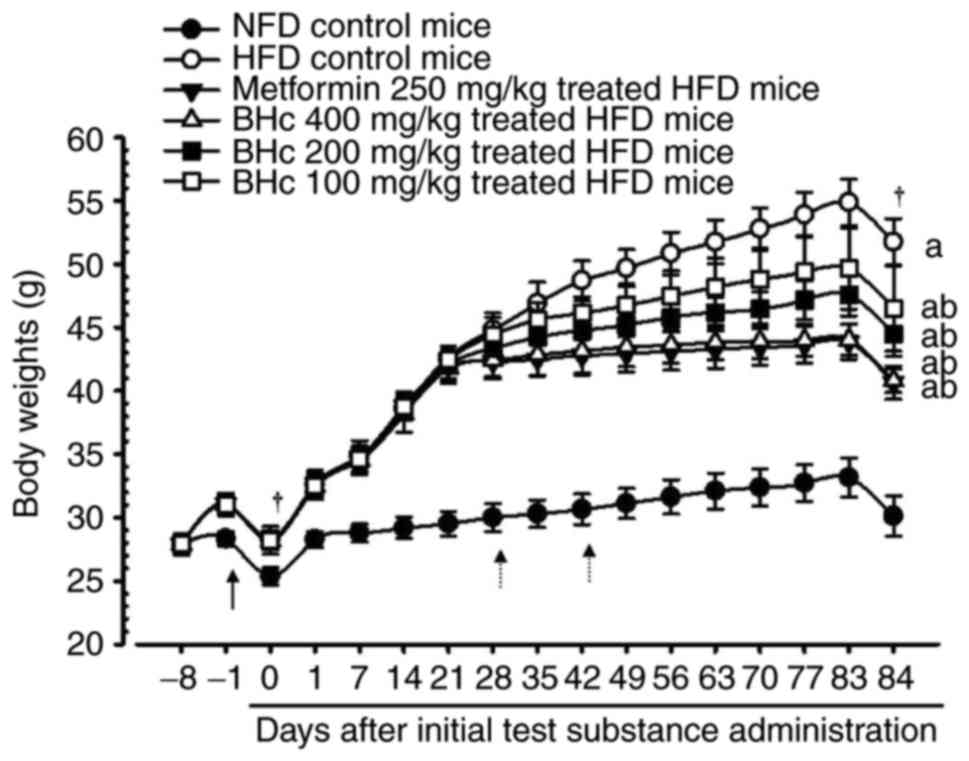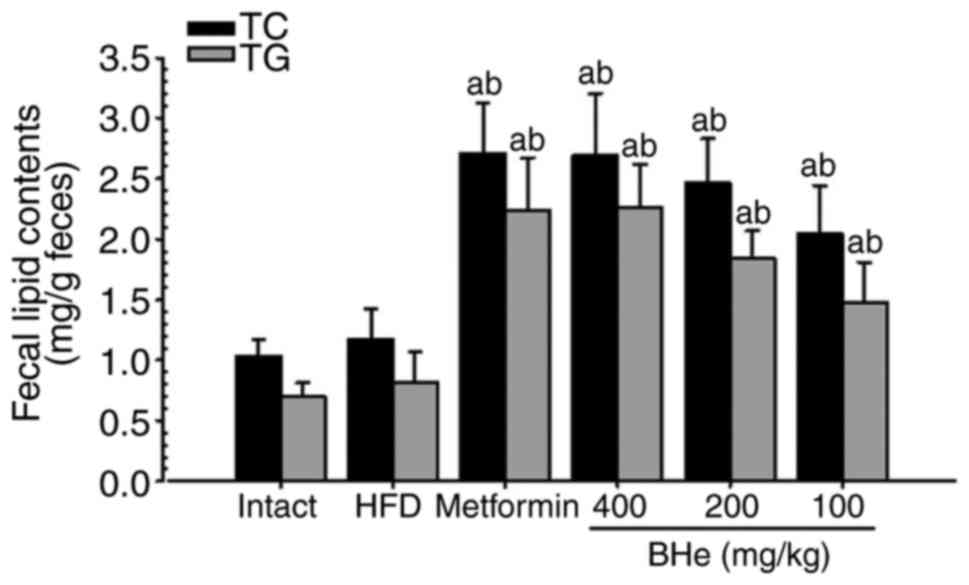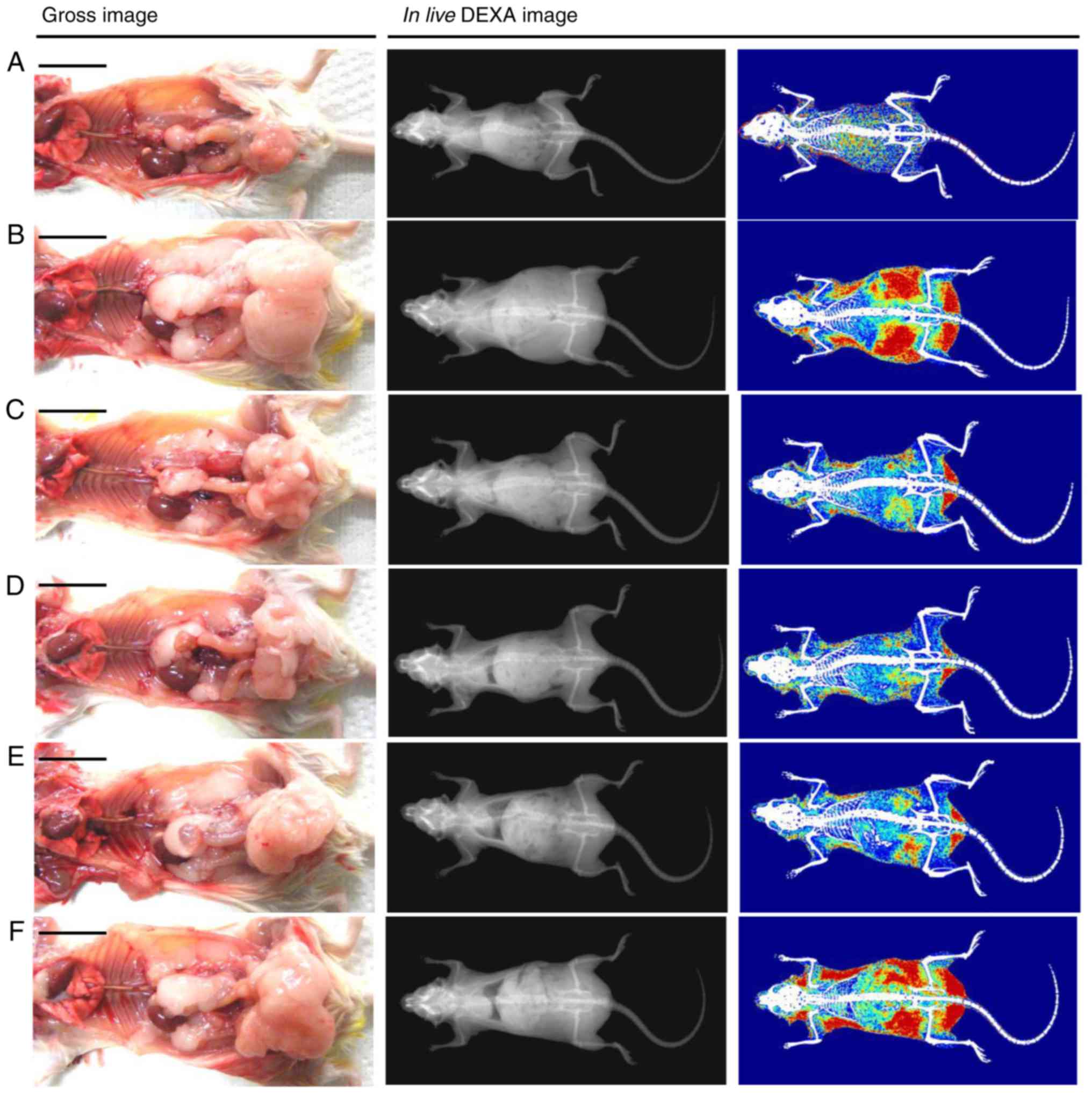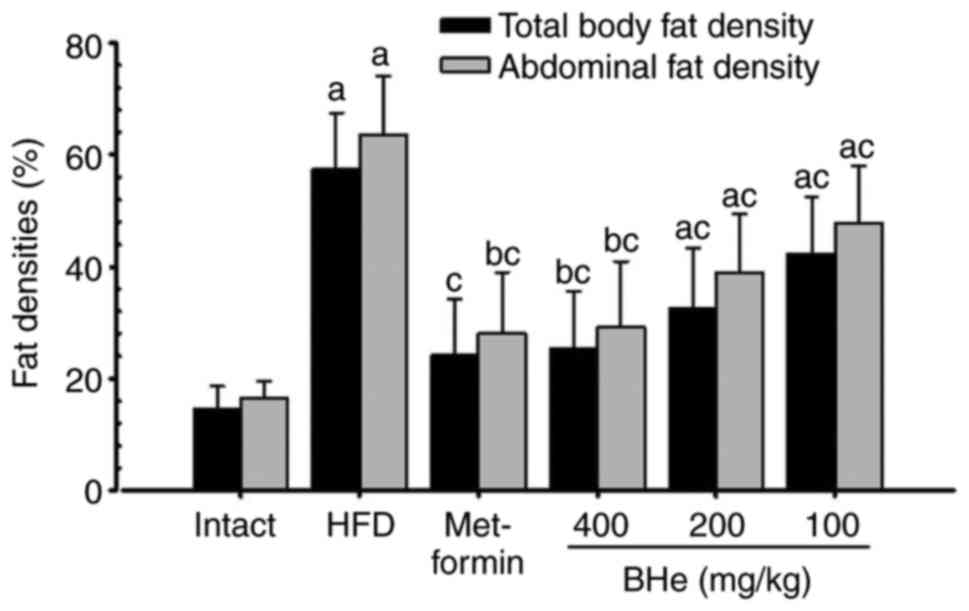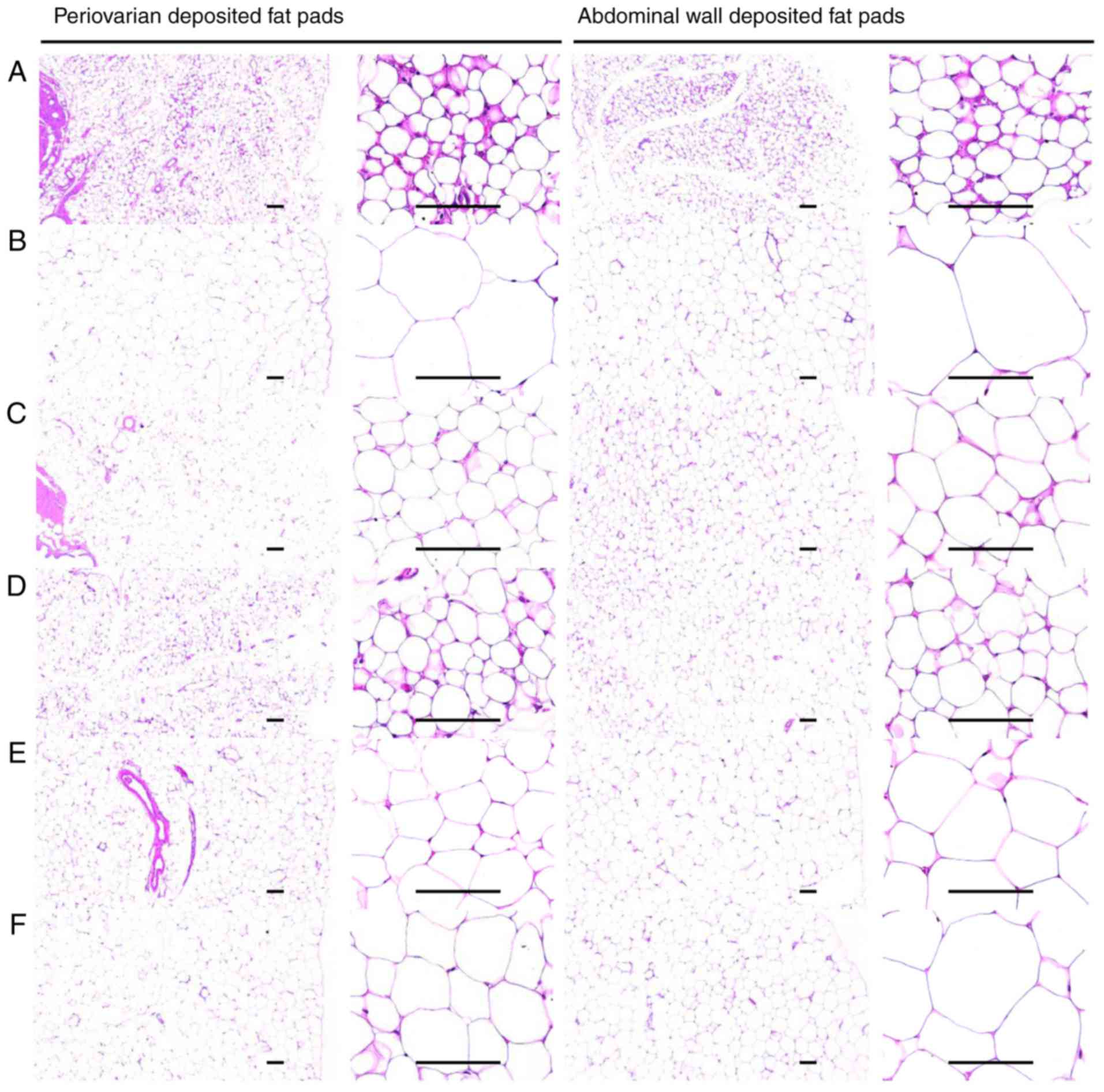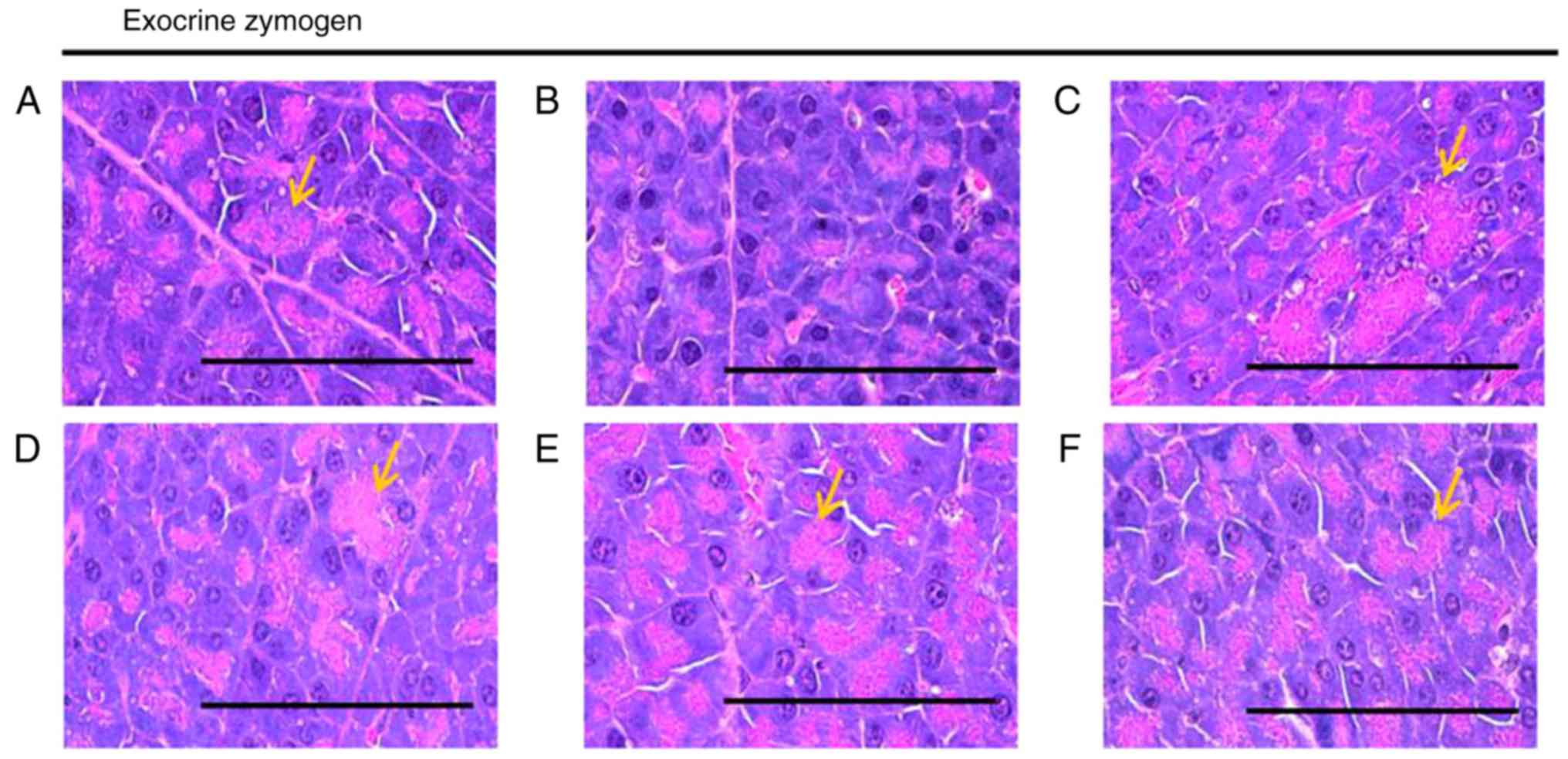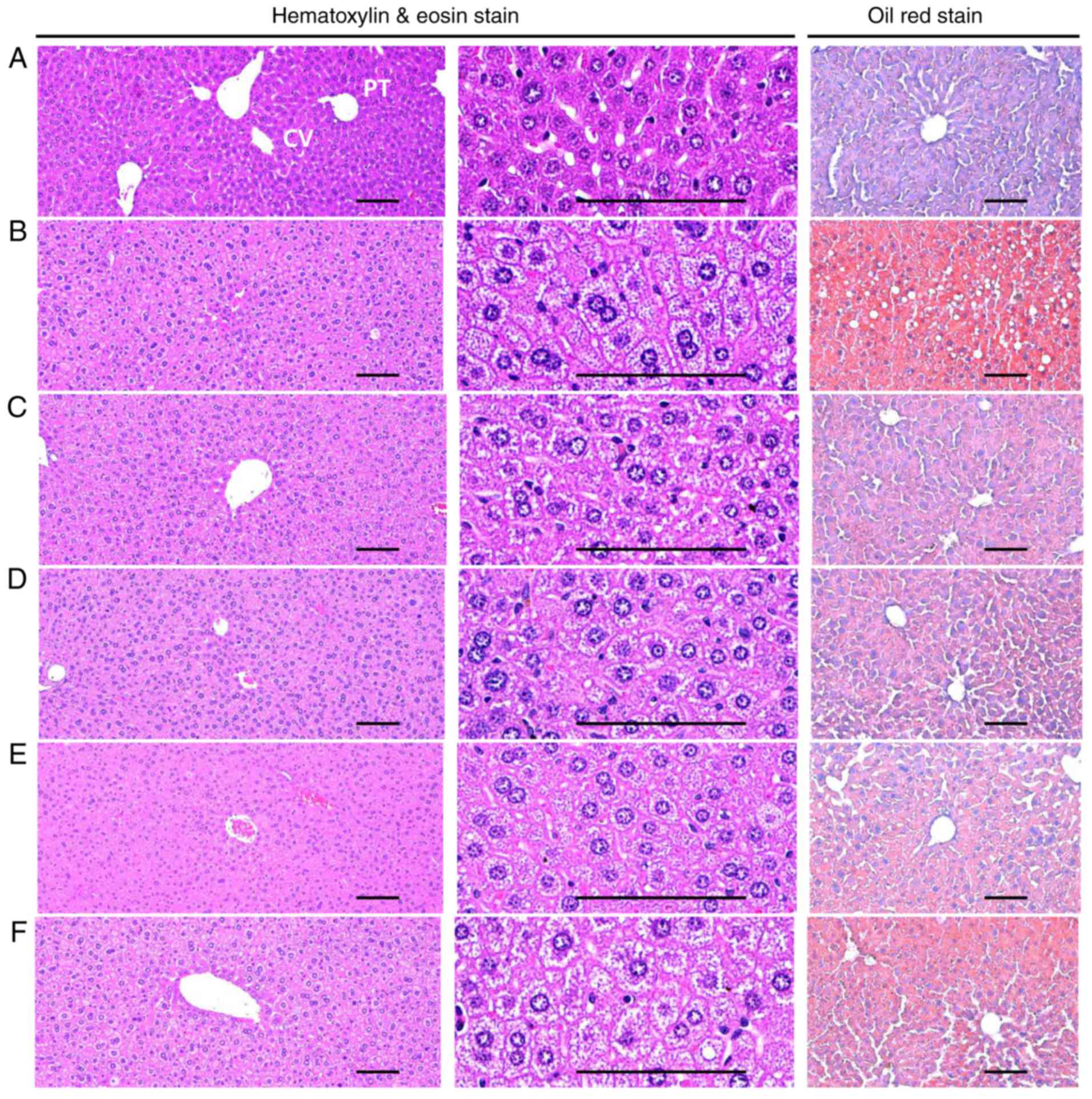|
1
|
Wendel AA, Purushotham A, Liu LF and
Belury MA: Conjugated linoleic acid fails to worsen insulin
resistance but induces hepatic steatosis in the presence of leptin
in ob/ob mice. J Lipid Res. 49:98–106. 2008. View Article : Google Scholar
|
|
2
|
Tilg H and Moschen AR: Adipocytokines:
Mediators linking adipose tissue, inflammation and immunity. Nat
Rev Immunol. 6:772–783. 2006. View
Article : Google Scholar : PubMed/NCBI
|
|
3
|
James PT, Leach R, Kalamara E and Shayeghi
M: The worldwide obesity epidemic. Obes Res. 9(Suppl 4): 228S–233S.
2001. View Article : Google Scholar : PubMed/NCBI
|
|
4
|
Flegal KM, Kruszon-Moran D, Carroll MD,
Fryar CD and Ogden CL: Trends in obesity among adults in the United
States 2005 to 2014. JAMA. 315:2284–2291. 2016. View Article : Google Scholar : PubMed/NCBI
|
|
5
|
Ogden CL, Carroll MD, Lawman HG, Fryar CD,
Kruszon-Moran D, Kit BK and Flegal KM: Trends in obesity prevalence
among children and adolescents in the United States, 1988–1004
through 2013–2014. JAMA. 315:2292–2299. 2016. View Article : Google Scholar : PubMed/NCBI
|
|
6
|
Kunitomi M, Wada J, Takahashi K,
Tsuchiyama Y, Mimura Y, Hida K, Miyatake N, Fujii M, Kira S,
Shikata K and Maknio H: Relationship between reduced serum IGF-I
levels and accumu-lation of visceral fat in Japanese men. Int J
Obes Relat Metab Disord. 26:361–369. 2002. View Article : Google Scholar : PubMed/NCBI
|
|
7
|
Hida K, Wada J, Eguchi J, Zhang H, Baba M,
Seida A, Hashimoto I, Okada T, Yasuhara A, Nakatsuka A, et al:
Visceral adipose tissue-derived serine protease inhibitor: A unique
insulin-sensitizing adipocytokine in obesity. Proc Natl Acad Sci
USA. 102:10610–10615. 2005. View Article : Google Scholar : PubMed/NCBI
|
|
8
|
Angulo P: Nonalcoholic fatty liver
disease. N Engl J Med. 346:1221–1231. 2002. View Article : Google Scholar : PubMed/NCBI
|
|
9
|
Park SH, Ko SK and Chung SH: Euonymus
alatus prevents the hyperglycemia and hyperlipidemia induced by
high-fat diet in ICR mice. J Ethnopharmacol. 102:326–335. 2005.
View Article : Google Scholar : PubMed/NCBI
|
|
10
|
Kim UH, Yoon JH, Li H, Kang JH, Ji HS,
Park KH, Shin DH, Park HY and Jeong TS: Pterocarpan-enriched soy
leaf extract ameliorates insulin sensitivity and pancreatic β-cell
proliferation in type 2 diabetic mice. Molecules. 19:18493–18510.
2014. View Article : Google Scholar : PubMed/NCBI
|
|
11
|
Tan Y, Kim J, Cheng J, Ong M, Lao WG, Jin
XL, Lin YG, Xiao L, Zhu XQ and Qu XQ: Green tea polyphenols
ameliorate non-alcoholic fatty liver disease through upregulating
AMPK activation in high fat fed Zucker fatty rats. World J
Gastroenterol. 23:3805–3814. 2017. View Article : Google Scholar : PubMed/NCBI
|
|
12
|
Lin CH, Kuo YH and Shih CC: Effects of
Bofu-Tsusho-San on diabetes and hyperlipidemia associated with
AMP-activated protein kinase and glucose transporter 4 in
high-fat-fed mice. Int J Mol Sci. 15:20022–20044. 2014. View Article : Google Scholar : PubMed/NCBI
|
|
13
|
Steinberg GR and Kemp BE: AMPK in Health
and disease. Physiol Rev. 89:1025–1078. 2009. View Article : Google Scholar : PubMed/NCBI
|
|
14
|
Xu XJ, Gauthier MS, Hess DT, Apovian CM,
Cacicedo JM, Gokce N, Farb M, Valentine RJ and Ruderman NB: Insulin
sensitive and resistant obesity in humans: AMPK activity, oxidative
stress, and depot-specific changes in gene expression in adipose
tissue. J Lipid Res. 53:792–801. 2012. View Article : Google Scholar : PubMed/NCBI
|
|
15
|
Hasanvand A, Amini-Khoei H, Hadian MR,
Abdollahi A, Tavangar SM, Dehpour AR, Semiei E and Mehr SE:
Anti-inflammatory effect of AMPK signaling pathway in rat model of
diabetic neuropathy. Inflammopharmacology. 24:207–219. 2016.
View Article : Google Scholar : PubMed/NCBI
|
|
16
|
Smith BK, Marcinko K, Desjardins EM, Lally
JS, Ford RJ and Steinberg GR: Treatment of nonalcoholic fatty liver
disease: Role of AMPK. Am J Physiol Endocrinol Metab.
311:E730–E740. 2016. View Article : Google Scholar : PubMed/NCBI
|
|
17
|
Ma A, Wang J, Yang L, An Y and Zhu H: AMPK
activation enhances the anti-atherogenic effects of high density
lipoproteins in apoE−/− mice. J Lipid Res. 58:1536–1547.
2017. View Article : Google Scholar : PubMed/NCBI
|
|
18
|
Mottillo EP, Desjardins EM, Fritzen AM,
Zou VZ, Crane JD, Yabut JM, Kiens B, Erion DM, Lanba A, Granneman
JG, et al: FGF21 does not require adipocyte AMP-activated protein
kinase (AMPK) or the phosphorylation of acetyl-CoA carboxylase
(ACC) to mediate improvements in whole-body glucose homeostasis.
Mol Metab. 6:471–481. 2017. View Article : Google Scholar : PubMed/NCBI
|
|
19
|
Kang SJ, Lee JE, Lee EK, Jung DH, Song CH,
Park SJ, Choi SH, Han CH, Ku SK and Lee YJ: Fermentation with
Aquilariae Lignum enhances the anti-diabetic activity of green tea
in type II diabetic db/db mouse. Nutrients. 6:3536–3571. 2014.
View Article : Google Scholar : PubMed/NCBI
|
|
20
|
Kim E, Liu NC, Yu IC, Lin HY, Lee YF,
Sparks JD, Chen LM and Chang C: Metformin inhibits nuclear receptor
TR4-mediated hepatic stearoyl-CoA desaturase 1 gene expression with
altered insulin sensitivity. Diabetes. 60:1493–1503. 2011.
View Article : Google Scholar : PubMed/NCBI
|
|
21
|
Torres TP, Sasaki N, Donahue EP, Lacy B,
Printz RL, Cherrington AD, Treadway JL and Shiota M: Impact of a
glycogen phosphorylase inhibitor and metformin on basal and
glucagon-stimulated hepatic glucose flux in conscious dogs. J
Pharmacol Exp Ther. 337:610–620. 2011. View Article : Google Scholar : PubMed/NCBI
|
|
22
|
Jones G, Macklin J and Alexander W:
Contraindications to the use of metformin. BMJ. 326:4–5. 2003.
View Article : Google Scholar : PubMed/NCBI
|
|
23
|
Bolen S, Feldman L, Vassy J, Wilson L, Yeh
HC, Marinopoulos S, Wiley C, Selvin E, Wilson R, Bass EB and
Brancati FL: Systematic review: Comparative effectiveness and
safety of oral medications for type 2 diabetes mellitus. Ann Intern
Med. 147:386–399. 2007. View Article : Google Scholar : PubMed/NCBI
|
|
24
|
Khurana R and Malik IS: Metformin: Safety
in cardiac patients. Heart. 96:99–102. 2010.
|
|
25
|
Chaovanalikit A, Thompson MM and Wrolstad
RE: Characterization and quantification of anthocyanins and
polyphenolics in blue honeysuckle (Lonicera caerulea L.). J Agric
Food Chem. 52:848–852. 2004. View Article : Google Scholar : PubMed/NCBI
|
|
26
|
Svarcova I, Heinrich J and Valentova K:
Berry fruits as a source of biologically active compounds: The case
of Lonicera caerulea. Biomed Pap Med Fac Univ Palacky Olomouc Czech
Repub. 151:163–174. 2007. View Article : Google Scholar
|
|
27
|
Zhao H, Wang Z, Ma F, Yang X, Cheng C and
Yao L: Protective effect of anthocyanin from lonicera caerulea var.
Edulis on Radiation-induced damage in mice. Int J Mol Sci.
13:11773–11782. 2012. View Article : Google Scholar : PubMed/NCBI
|
|
28
|
Jurgoński A, Juśkiewicz J and Zduńczyk Z:
An anthocyanin-rich extract from Kamchatka honeysuckle increases
enzymatic activity within the gut and ameliorates abnormal lipid
and glucose metabolism in rats. Nutrition. 29:898–902. 2013.
View Article : Google Scholar
|
|
29
|
Palíková I, Valentová K, Oborná I and
Ulrichová J: Protectivity of blue honeysuckle extract against
oxidative human endothelial cells and rat hepatocyte damage. J
Agric Food Chem. 57:6584–6589. 2009. View Article : Google Scholar : PubMed/NCBI
|
|
30
|
Jin XH, Ohgami K, Shiratori K, Suzuki Y,
Koyama Y, Yoshida K, Ilieva I, Tanaka T, Onoe K and Ohno S: Effects
of blue honeysuckle (Lonicera caerulea L.) extract on
lipopoly-saccharide-induced inflammation in vitro and in vivo. Exp
Eye Res. 82:860–867. 2006. View Article : Google Scholar
|
|
31
|
Park SI, Lee YJ, Choi SH, Park SJ, Song CH
and Ku SK: Therapeutic effects of blue honeysuckle on lesions of
hyperthyroidism in rats. Am J Chin Med. 44:1441–1456. 2016.
View Article : Google Scholar : PubMed/NCBI
|
|
32
|
Chen L, Xin X, Yuan Q, Su D and Liu W:
Phytochemical proper-ties and antioxidant capacities of various
colored berries. J Sci Food Agric. 94:180–188. 2014. View Article : Google Scholar
|
|
33
|
Vostálová J, Galandáková A, Palíková I,
Ulrichová J, Doležal D, Lichnovská R, Vrbková J and Rajnochová
Svobodová A: Lonicera caerulea fruits reduce UVA-induced damage in
hairless mice. J Photochem Photobiol B. 128:1–11. 2013. View Article : Google Scholar : PubMed/NCBI
|
|
34
|
Korea Food and Drug Administration:
Testing Guidelines for Safety Evaluation of Drugs. Notification No.
2015–082. 2015.
|
|
35
|
Kim CM, Yi SJ, Cho IJ and Ku SK: Red-koji
fermented red ginseng ameliorates high fat diet-induced metabolic
disorders in mice. Nutrients. 5:4316–4332. 2013. View Article : Google Scholar : PubMed/NCBI
|
|
36
|
Folch J, Lees M and Sloane-Stanley GH: A
simple method for the isolation and purification of total lipids
from animal tissues. J Biol Chem. 226:497–509. 1957.PubMed/NCBI
|
|
37
|
Jamall IS and Smith JC: Effects of cadmium
on glutathione peroxidase, superoxidase dismutase and lipid
peroxidation in the rat heart: A possible mechanism of cadmium
cardiotoxicity. Toxicol Appl Pharmacol. 80:33–42. 1985. View Article : Google Scholar : PubMed/NCBI
|
|
38
|
Lowry OH, Rosenbrough NJ, Farr AL and
Randall RJ: Protein measurement with the Folin phenol reagent. J
Biol Chem. 193:265–275. 1951.PubMed/NCBI
|
|
39
|
Sedlak J and Lindsay RH: Estimation of
total, protein-bound, and nonprotein sulfhydryl groups in tissue
with Ellman’s reagent. Anal Biochem. 25:192–205. 1968. View Article : Google Scholar : PubMed/NCBI
|
|
40
|
Aebi H: Catalase. Methods in Enzymatic
Analysis. Bergmeyer HU: Academic Press; New York NY: pp. 673–686.
1974, View Article : Google Scholar
|
|
41
|
Sun Y, Larry WO and Ying L: A simple
method for clinical assay of superoxide dismutase. Clin Chem.
34:497–500. 1988.PubMed/NCBI
|
|
42
|
Hulcher FH and Oleson WH: Simplified
spectrophotometric assay for microsomal 3-hydroxy-3-methylglutaryl
CoA reductase by measurement of coenzyme A. J Lipid Res.
14:625–631. 1973.PubMed/NCBI
|
|
43
|
Davidson AL and Arion WJ: Factors
underlying significant underestimations of glucokinase activity in
crude liver extracts: Physiological implications of higher cellular
activity. Arch Biochem Biophys. 253:156–167. 1987. View Article : Google Scholar : PubMed/NCBI
|
|
44
|
Alegre M, Ciudad CJ, Fillat C and
Guinovart JJ: Determination of glucose-6-phosphatase activity using
the glucose dehydrogenase-coupled reaction. Anal Biochem.
173:185–189. 1988. View Article : Google Scholar : PubMed/NCBI
|
|
45
|
Bentle LA and Lardy HA: Interaction of
anions and divalent metal ions with phosphoenolpyruvate
carboxykinase. J Biol Chem. 251:2916–2921. 1976.PubMed/NCBI
|
|
46
|
Sung YY, Kim DS, Kim SH and Kim HK:
Anti-obesity activity, acute toxicity, and chemical constituents of
aqueous and ethanol Viola mandshurica extracts. BMC Complement
Altern Med. 17:2972017. View Article : Google Scholar : PubMed/NCBI
|
|
47
|
Bashir KMI, Kim MS, Stahl U and Cho MG:
Agrobacterium-mediated genetic transformation of Dictyosphaerium
pulchellum for the expression of erythropoietin. J Appl Phycol.
1–16. 2018.
|
|
48
|
Schmittgen TD and Livak KJ: Analyzing
real-time PCR data by the comparative C(T) method. Nat Protoc.
3:1101–1108. 2008. View Article : Google Scholar : PubMed/NCBI
|
|
49
|
Levene A: Pathological factors influencing
excision of tumours in the head and neck. Part I. Clin Otolaryngol
Allied Sci. 6:145–151. 1981. View Article : Google Scholar : PubMed/NCBI
|
|
50
|
Choi JS, Kim JW, Park JB, Pyo SE, Hong YK,
Ku SK and Kim MR: Blood glycemia-modulating effects of melanian
snail protein hydrolysates in mice with type II diabetes. Int J Mol
Med. 39:1437–1451. 2017. View Article : Google Scholar : PubMed/NCBI
|
|
51
|
Williams CD, Stengel J, Asike MI, Torres
DM, Shaw J, Contreras M, Landt CL and Harrison SA: Prevalence of
nonalcoholic fatty liver disease and nonalcoholic steatohepatitis
among a largely middleaged population utilizing ultrasound and
liver biopsy: A prospective study. Gastroenterology. 140:124–131.
2011. View Article : Google Scholar
|
|
52
|
Wong VW, Chu WC, Wong GL, Chan RS, Chim
AM, Ong A, Yeung DK, Yiu KK, Chu SH, Woo J, et al: Prevalence of
non-alcoholic fatty liver disease and advanced fibrosis in Hong
Kong Chinese: A population study using proton-magnetic resonance
spectroscopy and transient elastography. Gut. 61:409–415. 2012.
View Article : Google Scholar
|
|
53
|
Samuel VT, Liu ZX, Qu X, Elder BD, Bilz S,
Befroy D, Romanelli AJ and Shulman GI: Mechanism of hepatic insulin
resistance in nonalcoholic fatty liver disease. J Biol Chem.
279:32345–32353. 2004. View Article : Google Scholar : PubMed/NCBI
|
|
54
|
Savage DB, Petersen KF and Shulman GI:
Disordered lipid metabolism and the pathogenesis of insulin
resistance. Physiol Rev. 87:507–520. 2007. View Article : Google Scholar : PubMed/NCBI
|
|
55
|
Rotman Y and Sanyal AJ: Current and
upcoming pharmaco-therapy for non-alcoholic fatty liver disease.
Gut. 66:180–190. 2017. View Article : Google Scholar
|
|
56
|
Jung YM, Lee SH, Lee DS, You MJ, Chung IK,
Cheon WH, Kwon YS, Lee YJ and Ku SK: Fermented garlic protects
diabetic, obese mice when fed a high-fat diet by antioxidant
effects. Nutr Res. 31:387–396. 2011. View Article : Google Scholar : PubMed/NCBI
|
|
57
|
Lee JE, Kang SJ, Choi SH, Song CH, Lee YJ
and Ku SK: Fermentation of green tea with 2% Aquilariae lignum
increases the anti-diabetic activity of green tea aqueous extracts
in the high fat-fed mouse. Nutrients. 7:9046–9078. 2015. View Article : Google Scholar : PubMed/NCBI
|
|
58
|
Fujita H, Fujishima H, Koshimura J, Hosoba
M, Yoshioka N, Shimotomai T, Morii T, Narita T, Kakei M and Ito S:
Effects of antidiabetic treatment with metformin and insulin on
serum and adipose tissue adiponectin levels in db/db mice. Endocr
J. 52:427–433. 2005. View Article : Google Scholar : PubMed/NCBI
|
|
59
|
Gartner LP and Hiatt JL: Color Textbook of
Histology. 3rd edition. Saunders; Philadelphia: pp. 417–422.
2007
|
|
60
|
Bertrand RL, Senadheera S, Markus I, Liu
L, Howitt L, Chen H, Murphy TV, Sandow SL and Bertrand PP: A
Western diet increases serotonin availability in rat small
intestine. Endocrinology. 152:36–47. 2011. View Article : Google Scholar
|
|
61
|
Snedeker SM and Hay AG: Do interactions
between gut ecology and environmental chemicals contribute to
obesity and diabetes. Environ Health Perspect. 120:332–339. 2012.
View Article : Google Scholar
|
|
62
|
Carter D, Howlett HC, Wiernsperger NF and
Bailey C: Effects of metformin on bile salt transport by monolayers
of human intestinal Caco-2 cells. Diabetes Obes Metab. 4:424–427.
2002. View Article : Google Scholar : PubMed/NCBI
|
|
63
|
Carter D, Howlett HC, Wiernsperger NF and
Bailey CJ: Differential effects of metformin on bile salt
absorption from the jejunum and ileum. Diabetes Obes Metab.
5:120–125. 2003. View Article : Google Scholar : PubMed/NCBI
|
|
64
|
Chen H, Qu Z, Fu L, Dong P and Zhang X:
Physicochemical properties and antioxidant capacity of 3
polysaccharides from green tea, oolong tea, and black tea. J Food
Sci. 74:C469–C474. 2009. View Article : Google Scholar : PubMed/NCBI
|
|
65
|
Quine SD and Raghu PS: Effects of
(−)-epicatechin, a flavonoid on lipid peroxidation and antioxidants
in streptozotocin-induced diabetic liver, kidney and heart.
Pharmacol Rep. 57:610–615. 2005.PubMed/NCBI
|
|
66
|
Sodikoff CH: Laboratory profiles of small
animal diseases: A guide to laboratory diagnosis. Mosby Inc.; St.
Louise; pp. 1–36. 1995
|
|
67
|
Wu X, Motoshima H, Mahadev K, Stalker TJ,
Scalia R and Goldstein BJ: Involvement of AMP-activated protein
kinase in glucose uptake stimulated by the globular domain of
adiponectin in primary rat adipocytes. Diabetes. 52:1355–1363.
2013. View Article : Google Scholar
|















